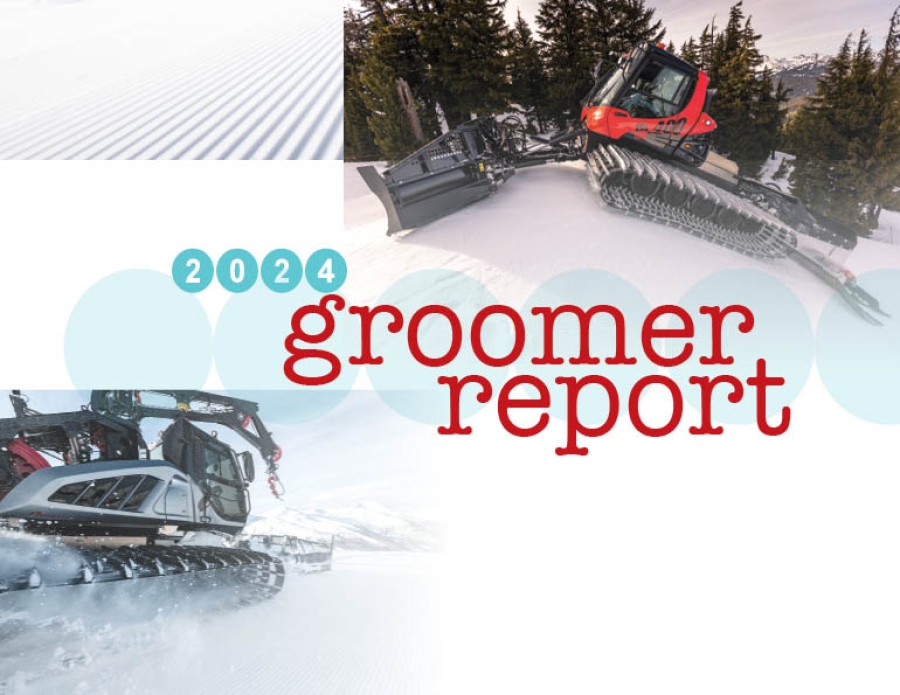“The highly competitive marketplace for snow grooming equipment is at something of a crossroads …
“The long-developing focus for this is the level of technological sophistication that is appropriate for the market. The complex equation still includes a host of such standby variables as fuel capacity, weight-to-horsepower ratio and the like, but to which have been added the most complex factors of all: the human ones. How do you get human productivity to take advantage of the amazing potential productivity of the machine?”
While that all sounds very current, these words were written 35 years ago by SAM founder David Rowan in the January 1989 issue. At the time, grooming machines were quickly becoming more technologically advanced, and ski areas were struggling to find and keep qualified operators. To help with the latter, cab design was “stage center,” with manufacturers introducing new improvements and technology aimed at operator comfort and efficiency.
Sound familiar? A lot has changed in groomers and grooming since 1989, but much remains the same. The struggle to find and retain snowcat operators—and mechanics, too—has only become more acute, and manufacturers continue to refine their machines in an effort to make them more efficient in every sense of the word, including ease of operation, fuel consumption, and productivity.
This year’s theme: After years of tweaks and changes—big and small, inside and out—both PistenBully and Prinoth have reached a point of consistency across their fleets, which should ease the learning curve for operators and mechanics.
CONSISTENCY, EFFICIENCY, AVAILABILITY
Operator efficiency starts in the cab, where intuitive controls, ergonomic layout, and comfort combine to make long shifts less onerous. Notably, both manufacturers have recently completed the transition to a uniform cab layout across all models. Similarly, on the maintenance side, different models are being built with many of the same parts and components, making the tech’s work more efficient.
PistenBully
Every PistenBully model now has the same operator platform and controls—including the joystick that controls four blade functions simultaneously and the iTerminal touchscreen systems display. The new platform and controls were introduced in the PB 100 in 2015, in the PB 600 in 2018, and “we completed the circle in 2022-23,” says PistenBully/SNOWsat vice president Jeb Ellermeyer, when all PB 400s followed suit.
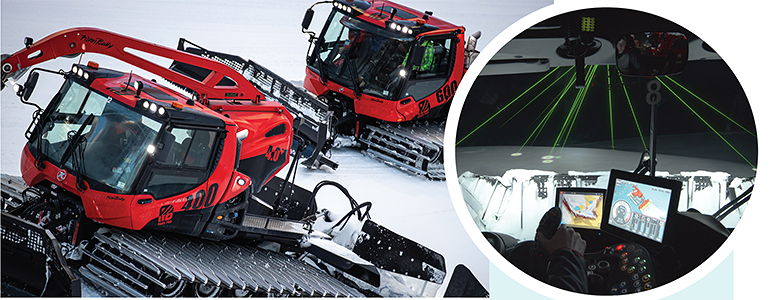 Left: PistenBully 400 ParkPro W and the new 600 ParkPro. Right: Cockpit view of PistenBully iTerminal and SNOWsat LiDAR.
Left: PistenBully 400 ParkPro W and the new 600 ParkPro. Right: Cockpit view of PistenBully iTerminal and SNOWsat LiDAR.
From a maintenance standpoint, the machines share a lot of the same hydraulic and electrical architecture, with the same part numbers and wire numbers. And the PB 100, PB 400, and PB 600 are all powered by Cummins engines. So, if a mechanic is trained to work on the 600, it’s very similar to the 400 and the 100, as well as the ParkPro and winch trims.Ellermeyer likens this to Southwest Airlines deciding early on that it was only going to fly Boeing 737s, which streamlined the training for both pilots and mechanics, and also streamlined the parts inventory, resulting in tremendous efficiencies.
“In some ways, we’re trying to do that same thing,” says Ellermeyer—that is, simplify the parts portfolio and improve parts availability.
Prinoth
As of 2023, all Prinoth models—Husky, Bison, and Leitwolf—have come standard with the Prinoth Control Unit, which includes the “joystick-in-joystick” tiller and blade control and 12-inch, tilting touchscreen. Operators can configure the interface to their preferences and save those settings, so each operator’s custom configuration appears upon startup.
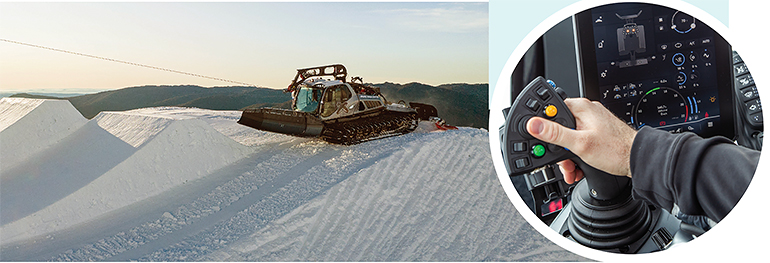 Left: Prinoth Leitwolf X Winch at home in the park. Right: Prinoth Control Unit with joystick-in-joystick.
Left: Prinoth Leitwolf X Winch at home in the park. Right: Prinoth Control Unit with joystick-in-joystick.
All three models are now powered by engines that meet stringent EU stage V emissions standards. After several years of changes in response to emissions control requirements, this consistency is good for maintenance teams, says Scott Jones, general manager of Prinoth snow grooming, North America.
Jones says a big focus for Prinoth in North America is customer service, which includes parts and service availability. It is expanding the capabilities of its regional distribution hubs by adding more technicians and parts inventory, as well as a new Midwestern warehouse. Following Prinoth’s acquisition of tree-care equipment provider Jarraff Industries—based in Minnesota—it is adding groomer parts inventory, sales, and service techs at Jarraff’s headquarters. Parts for Midwest customers previously came from Prinoth’s Concord, N.H., hub.
THE MACHINES
PistenBully
The biggest change for 2024-25 is that all PistenBully models—100, 400, and 600—will be available in the ParkPro package. This option provides operators with additional versatility beyond the 400 ParkPro—the power and size of the 600, or the agility and precision of the 100—along with the greater range of motion of the front and rear implements, which can be useful for both park building and trail grooming. The unification of the operating platform, four-way joystick, and other alignments allowed for this to happen, says Ellermeyer.
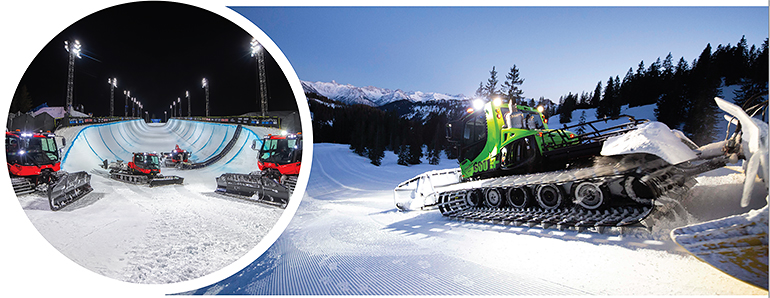 Left: PistenBully’s ParkPro family—100, 400, 600—in the pipe. Right: The PistenBully hybrid diesel-electric 600 E+.
Left: PistenBully’s ParkPro family—100, 400, 600—in the pipe. Right: The PistenBully hybrid diesel-electric 600 E+.
All ParkPro models come with the ProBlade, which includes hydraulic transport tines for carrying terrain park features, side cutters and unique side edges and corners for shaping, and wings that can be tilted backwards for better snow transport. The ProFlexTiller can adjust to the contour of the slope, and be set in “A” or “V” positions.
Ellermeyer reports that the market is strong for the diesel-electric hybrid 600 E+. It’s a premium machine in the PistenBully lineup that, in the next year or two, will be on its third generation because “electric technology is changing quicker than hydraulic technology is,” he says.
The PB 400 remains the most popular model for PistenBully, thanks to its versatility and variety of trims. These include a ParkPro Winch option with the 4.0+ winch and AutoWinch function that automatically determines how much force needs to be applied, which Ellermeyer says allows less experienced operators to be efficient operating a winch cat.
The PB 600 Polar is the biggest in the lineup, with an AllWayBlade more than 18 feet wide when open and a corduroy swath of more than 20 feet with the foldable side finishers down.
In an effort to make operations more efficient, all PistenBully models come standard with AutoTracer active steering assistance for the tiller, and SlopeTracer automatically adapts to hilly terrain and adjusts the milling depth.
Prinoth
All Prinoth X machines—which have twice the range of motion for the front and rear implements compared to the standard trims, built-in inclinometers, and other features geared toward park building—will come standard with the new X Blade beginning in 2024-25. The wings of the X Blade were re-worked to have more rounded corners on the bottom cutting edge, straight ends that will make cutting snow easier, and transport cups on top of the side wings to allow for the picking up and transporting of park features. The shaping kit option includes side-cutting plates and adjustable back-blading plates that can be bolted to the wings.
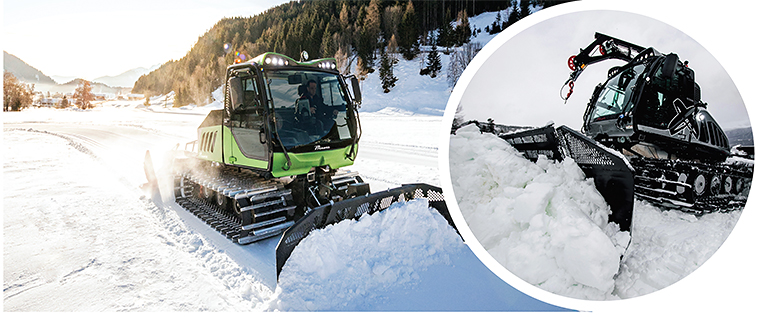 Left: The Prinoth Husky E-Motion has arrived in North America. Right: Prinoth Bison X with Automatic Winch.
Left: The Prinoth Husky E-Motion has arrived in North America. Right: Prinoth Bison X with Automatic Winch.
Also new for 2024-25: Heavy-Duty open profile steel tracks, which have been upgraded to a thicker and stronger steel to improve the lifespan of the grousers.
Jones says the Bison is still the predominant Prinoth snowcat in North America due to its size and versatility. The Bison is powered by a 422-hp Caterpillar engine and comes in standard, X, and winch trims. The PosiFlex and Power tillers each provide roughly 20 feet of corduroy on each pass with side wings lowered.
While the Bison is the most popular, the Leitwolf “is gaining steam very quickly” in North America, Jones says. This trend has been ongoing, especially for ski areas that didn’t think they needed a larger machine like the Leitwolf only a couple years ago. Its 530-hp Mercedes engine and wide footprint allow for greater production and more pushing power, while an active adjustable suspension allows the operator to lift the front, rear, or both ends of the tracks to change the footprint depending on snow conditions or for needed maneuverability.
GOING ELECTRIC
PistenBully
PistenBully is continuing to test the third generation of its all-electric 100 E this winter, and Ellermeyer expects it to be available to the market soon. The company is incorporating quickly-changing technology to include lighter and more efficient components.
The 100 E has an all-electric drivetrain: four batteries run two electric drive motors that turn the tracks and an electric tiller motor. PistenBully says this is 20 percent more efficient than a central electric motor. The minimum charging time is about two hours at 100 kW.
As is the case for all electric vehicles, battery capacity is the greatest limiting factor in runtime, and the current technology allows for roughly three hours. Adding bigger batteries isn’t an option, due to weight, “So the best thing we can do right now to increase the runtime is to continue to work on a more efficient drivetrain,” says Ellermeyer.
Prinoth
Taos Ski Valley, N.M., received delivery of a Prinoth Husky E-Motion X in January—the first battery-powered electric snowcat in North America. In testing since 2020, the E-Motion has a runtime of roughly three hours and a similar charge time. The installed traction battery powers a 245-hp electric motor; from there, it runs a traditional hydrostatic circuit—the same as the diesel-powered Husky. That, according to Prinoth global portfolio manager Andreas Muigg, eases maintenance for technicians familiar with the systems.
The E-Motion delivers immediate 737-ft-lb of torque and comes with the added benefit of quiet operation. It’s available in two configurations: Cross Country with options for Nordic liner attachments to set tracks; and the X package that includes a blade and tiller with greater range of motion, LED lights, inclinometers on both the vehicle and blade, a distance measurement tool, and a rearview camera to assist in park building.
Taos is using its Husky E-Motion X for a variety of functions, says director of mountain maintenance Tommy Murray. These include building and maintaining its terrain enhanced learning area, cleaning out lift-loading areas, grooming the kids’ beginner hill, hauling food and supplies to the mid-mountain restaurant, and pulling the dinner sleigh for rides to the resort’s backside restaurant.
SOFTWARE AND TRAINING
In response to high turnover among operators and mechanics, both manufacturers have also continued to refine their software programs for fleet and snow management, as well as the training programs they offer.
PistenBully
Software programs. PistenBully is introducing the new iX operating platform for its SNOWsat software. Ellermeyer says this provides more features for the operator, along with a customizable user interface that each operator can save and pull up at the beginning of their shift. SNOWsat offers light and dark modes, like your mobile device, to adjust to light conditions for ease of readability.
SNOWsat iX is also optimized to work with PistenBully’s predictive snow-depth measurement technology, SNOWsat LiDAR, introduced in 2023. LiDAR measures snow depth up to 165 feet in front of and to the side of the grooming machine, increasing efficiency for both grooming and snowmaking.
SNOWsat also provides fleet management to help evaluate vehicle efficiency by analyzing the best routes, idle times, speeds, and RPMs of resort vehicles—not just snowcats—in order to maximize fuel consumption and reduce downtime. SNOWsat Maintain helps track and organize workflows for maintenance tasks of several mountain ops functions (vehicles, buildings, snowmaking, etc.), including scheduling and troubleshooting.
Training. PistenBully Pro Academy offers online training for both mechanics and operators with a total of more than 25 different training modules. For operators, there are machine-specific modules that start with entry-level and go up to pro-level. The growing list of training modules for mechanics, developed in response to feedback from customers, includes intro and advanced classes for hydraulics, electronics, and Cummins engine work.
Prinoth
Software programs. Prinoth Connect, linked to resort management platform Skadii, offers fleet management, snow-depth measurement using triangular meshing to create a model of the terrain, task management, and maintenance overview capabilities on one platform. Information and data can be shared across modules.
Training. Jones says Prinoth Academy offers a hybrid training platform for both service technicians and operators, with online modules as well as the option of hands-on training for operators with a Prinoth demo operator. Jones thinks it’s more beneficial to get cat time with a trainer “and actually walk the operator through the functions, the capabilities,” and other details, but admits that isn’t always practical. One obstacle: the level of turnover ski areas are experiencing, which can make it cost prohibitive to hire Prinoth to train new operators annually.
“But I’d say those that do take advantage of our [in-person] training are seeing the benefits of a more efficient operation in their snowcat,” he says.
Prinoth Academy technician training includes a variety of online modules that take participants through a three-level system: basic, advanced, and expert. Passing a test at the end of each level qualifies the participant to move on to the next. A certificate of completion is provided at the end. Resort teams can also sign up for onsite training following completion of the online curriculum.
HVO IS A GO
The use of hydrotreated vegetable oil (HVO), aka renewable diesel, to fuel grooming machines is taking off, and both manufacturers fully support using it in their snowcats in lieu of petroleum diesel.
“We are 100 percent behind it,” says Ellermeyer. “In fact, every new PistenBully that comes off the assembly line in Germany is delivered with HVO fuel.” He notes that Cummins doesn’t have any warranty restrictions for using HVO fuels in its engines.
Jones says Prinoth also backs use of HVO. “We say if you use HVO in our engines, it’s a 90 percent reduction in carbon emissions, and a 30 percent reduction in NOx (nitrogen oxides).”
To avoid greenwashing the numbers, he adds, “We acknowledge that you still have to get the fuel from a source to your mountain, so, taking that into account, we say maybe it’s a 60 percent reduction in emissions—which is still a humungous reduction.”
Resorts are heeding the call. Big Sky Resort, Mont., switched its entire diesel-engine fleet of vehicles, including trucks, snowcats, and other heavy equipment, to R99 HVO (a blend of 99-percent HVO, 1 percent fossil diesel); Compagnie des Alpes, which operates many of the largest resorts in France, switched all 130 snowcats across its properties to HVO.
The U.S. Energy Information Administration (EIA) forecasts renewable diesel production to grow quickly as new refineries are built and current ones expand, increasing from an estimated 3.85 billion gallons per year as of November 2023 to possibly 5.9 billion gallons per year by the end of 2025. Canada’s first renewable diesel factory was recently completed in British Columbia, with more expected to be built soon.
With greater capacity, adoption by resorts will likely grow as the market improves. “I think that price point is going to be less prohibitive, and accessibility will just get better and better over the years,” says Jones.
Lack of awareness has hindered adoption, Ellermeyer believes. “Unfortunately, using HVO in snowcats is something many people don’t see, and is not something that the public or even the operator would likely know about,” he says.
FINAL PASS
In today’s challenging labor market, the question of how much technology is too much will almost always be answered by pointing to the need to reduce the amount of skill and experience required to successfully groom snow. While many seasoned operators and mechanics may disagree, hiring and training new grooming staff every season is a reality for most ski areas, and technology plays a role in easing that burden.





